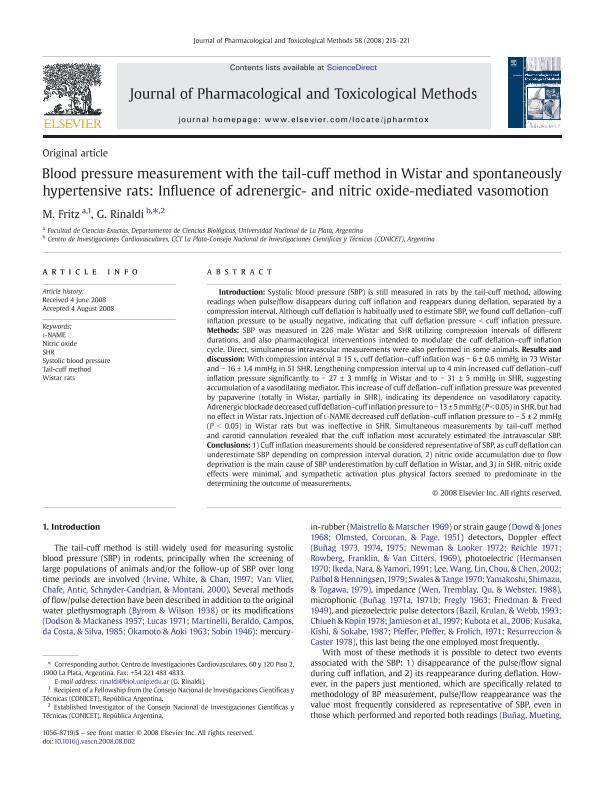Artículo
Blood pressure measurement with the tail-cuff method in Wistar and spontaneously hypertensive rats: Influence of adrenergic- and nitric oxide-mediated vasomotion
Fecha de publicación:
12/2008
Editorial:
Elsevier
Revista:
Journal Of Pharmacological And Toxicological Methods.
ISSN:
1056-8719
Idioma:
Inglés
Tipo de recurso:
Artículo publicado
Clasificación temática:
Resumen
Introduction: Systolic blood pressure (SBP) is still measured in rats by the tail-cuff method, allowing readings when pulse/flow disappears during cuff inflation and reappears during deflation, separated by a compression interval. Although cuff deflation is habitually used to estimate SBP, we found cuff deflation-cuff inflation pressure to be usually negative, indicating that cuff deflation pressure < cuff inflation pressure. Methods: SBP was measured in 226 male Wistar and SHR utilizing compression intervals of different durations, and also pharmacological interventions intended to modulate the cuff deflation-cuff inflation cycle. Direct, simultaneous intravascular measurements were also performed in some animals. Results and discussion: With compression interval ≅ 15 s, cuff deflation-cuff inflation was - 6 ± 0.6 mmHg in 73 Wistar and - 16 ± 1.4 mmHg in 51 SHR. Lengthening compression interval up to 4 min increased cuff deflation-cuff inflation pressure significantly to - 27 ± 3 mmHg in Wistar and to - 31 ± 5 mmHg in SHR, suggesting accumulation of a vasodilating mediator. This increase of cuff deflation-cuff inflation pressure was prevented by papaverine (totally in Wistar, partially in SHR), indicating its dependence on vasodilatory capacity. Adrenergic blockade decreased cuff deflation-cuff inflation pressure to - 13 ± 5 mmHg (P < 0.05) in SHR, but had no effect in Wistar rats. Injection of l-NAME decreased cuff deflation-cuff inflation pressure to - 5 ± 2 mmHg (P < 0.05) in Wistar rats but was ineffective in SHR. Simultaneous measurements by tail-cuff method and carotid cannulation revealed that the cuff inflation most accurately estimated the intravascular SBP. Conclusions: 1) Cuff inflation measurements should be considered representative of SBP, as cuff deflation can underestimate SBP depending on compression interval duration, 2) nitric oxide accumulation due to flow deprivation is the main cause of SBP underestimation by cuff deflation in Wistar, and 3) in SHR, nitric oxide effects were minimal, and sympathetic activation plus physical factors seemed to predominate in the determining the outcome of measurements.
Palabras clave:
L-NAME
,
NITRIC OXIDE
,
SHR
,
SYSTOLIC BLOOD PRESSURE
,
TAIL-CUFF METHOD
,
WISTAR RATS
Archivos asociados
Licencia
Identificadores
Colecciones
Articulos(CIC)
Articulos de CENTRO DE INVEST.CARDIOVASCULARES (I)
Articulos de CENTRO DE INVEST.CARDIOVASCULARES (I)
Articulos(CIDCA)
Articulos de CENTRO DE INV EN CRIOTECNOLOGIA DE ALIMENTOS (I)
Articulos de CENTRO DE INV EN CRIOTECNOLOGIA DE ALIMENTOS (I)
Citación
Fritz, Mariana; Rinaldi, Gustavo Juan; Blood pressure measurement with the tail-cuff method in Wistar and spontaneously hypertensive rats: Influence of adrenergic- and nitric oxide-mediated vasomotion; Elsevier; Journal Of Pharmacological And Toxicological Methods.; 58; 3; 12-2008; 215-221
Compartir
Altmétricas




